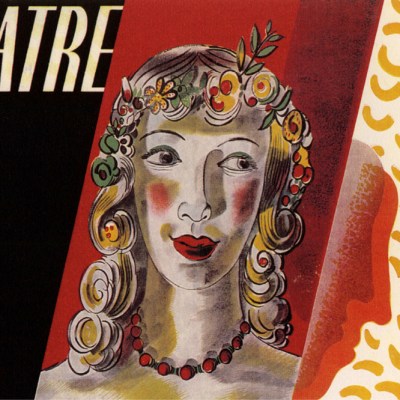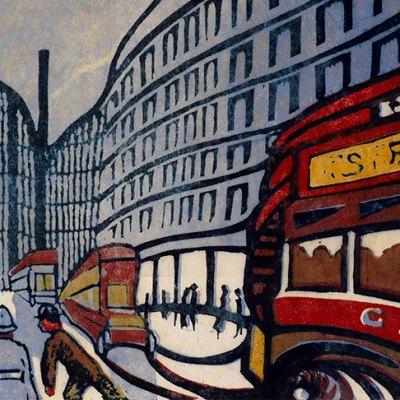It’s surprising that there has never previously been an exhibition dedicated to Bill Brandt and Henry Moore. There is an obvious aesthetic similarity between much of their work, for a start: Brandt’s semi-abstract photographs of nudes, of body parts juxtaposed with pebbles and rocks, clearly call to mind the rounded three-dimensional figures Moore never grew tired of producing. Brandt could make the human form look like a stone; for Moore it was the other way round. Lawrence Durrell, in his introduction to Perspective of Nudes (1961), the book that ignited Brandt’s reputation as an artist, called the photographer’s work ‘a prolonged meditation on the mystery of forms’. The same could be said of Moore’s sculptures.
There are other points of contact. Born only six years apart, Moore in 1898 and Brandt in 1904, both men were drawn to specific subjects and themes: London during the Second World War, the lives of coal miners in the north of England, certain elemental aspects of the British landscape. Brandt liked to photograph sculptures: memorably, when he visited Barbara Hepworth in St Ives, he arranged for her works to be transported to the beach, where he photographed them in dramatic fashion. Both Brandt and Moore achieved popularity in part owing to their understanding of photography as a medium. Brandt was expert in manipulating his prints (not to mention his subjects) to get the desired visual effect; later in his career he adapted his images cannily to meet the needs of the international art market. Moore, meanwhile, knew that only through photography could his sculptures reach the widest possible audience and thought very deeply about how to photograph them advantageously. ‘I have often noticed that people, after seeing a good photograph of a piece of sculpture which until then they had more or less ignored, find their interest in the original greatly increased,’ he wrote in 1935.
Nude, East Sussex Coast (1959), Bill Brandt. Photo: Richard Caspole; © Bill Brandt/Bill Brandt Archive Ltd

‘Bill Brandt/Henry Moore’, newly reopened at the Hepworth Wakefield gallery after an enforced hiatus, provides an engaging and enjoyable tour of all these points of convergence. Brandt and Moore first met in 1942, when Brandt travelled to Perry Green in Hertfordshire to photograph the sculptor in his studio. The resulting portrait appeared in Lilliput in December that year. The same issue of the magazine carried, side by side on double-page spreads, Brandt’s and Moore’s images of Londoners huddled underground, sheltering from the Blitz. Moore’s haunting sketches – commissioned, like Brandt’s, by the Ministry of Information – struck a chord with the public and he subsequently enlarged them into finished drawings for display in Kenneth Clark’s exhibitions of war art at the National Gallery. The popularity of these drawings played a large role in Moore being adopted, after the war, as a figurehead of British art; before the war his work had by no means been universally admired. Perhaps the images were successful because they gave poetic, timeless form to people suffering the discomfort and indignities imposed by war. When set against Brandt’s takes on the same subject, however, one can’t help feeling that Moore’s images are rather generic; indeed, Moore himself described the shelterers as looking like ‘hundreds of Henry Moore reclining figures’. Brandt had a nose for living human detail – the man sleeping in a coffin in a church crypt, the woman resting in a wine merchant’s cellar – and a knack for composition that makes the eye want to linger on his work. The same can be said of the photographs he took of the collieries and mining towns of northern England in the late 1930s, which were used during and after the war to illustrate articles in various publications calling for social reform. Moore’s interest in the mines was as a war artist – coal was vital to the war effort – and in 1942, off the back of the shelter drawings, he went back to his hometown of Castleford in West Yorkshire, where his father had worked as a pit manager, and descended into the mines (as Brandt had not) to depict the men at work. Unlike the shelter drawings, which were based on photographs and furtive sketches, these images were drawn unashamedly from life; a photo-story from Illustrated shows the artist, with a sketchpad and a headlamp, drawing while the miners toiled.
Coal-Miner’s Bath, Chester-le-Street, Durham (1937), Bill Brandt. Photo: Yale Center for British Art; © Bill Brandt/Bill Brandt Archive Ltd

The curators are keen to stress the material context of the exhibition’s contents: there are actual copies of Lilliput on display, for instance, and many of the prints are unframed and carry their creators’ markings on and around them. One wall shows the evolution of Elephant and Castle, Brandt’s photograph from 1940 of people sleeping on a south London underground platform. Initially a light-filled image with plenty of incidental detail, suitable for publication in Front Line 1940–1941, the ‘official story of the civil defence of Britain’, over the years Brandt increased both the contrast, giving it the large areas of pitch black that were a signature of his style, and the size, thus preparing it for publication in his own books and ultimately for sale at the high-end Marlborough Gallery. If the exhibition has a failing, it is that this notion of materiality is overemphasised at the expense of biographical and historical context. What, for instance, did the two men think of each other’s work? Some exploration of their role in bringing modernism to a conservative British public would have been illuminating. The accompanying book particularly, though exquisitely produced, tends to privilege theory over information.
Installation view of Reclining Figure (1936), Henry Moore, with prints from Perspective of Nudes (1961) by Bill Brandt at Hepworth Wakefield. Photo: Nick Singleton; © The Hepworth Wakefield

The highlight of ‘Bill Brandt/Henry Moore’ comes at the end. Having begun with war and darkness – literally, since Brandt’s sepulchral pictures of London during the black-out are the first images on display – the exhibition opens out into two large, light-filled rooms, in the second of which two of the large reclining female figures Moore carved in elmwood between 1935 and 1978 are on display, surrounded on three sides by prints from Brandt’s Perspective of Nudes. Anyone who visits the show now, with coronavirus safety measures in place, will benefit from the fact that only a limited number of people are allowed in each room at a time. What would have previously been an unthinkably luxurious amount of space for the average art-goer to move about in turns out to be crucial for engaging with these works, since every large Moore sculpture occupies not just its own physical footprint but also the area around it. Photography and sculpture, wood, stone, sea and the human form: all play off each other, offering the viewer a different perspective with each step and turn of the head. Both Brandt and, particularly, Moore may have suffered from overexposure over the years, but to see them presented in this way is invigorating.
‘Bill Brandt/Henry Moore’ is at the Hepworth Wakefield until 1 November.
From the September 2020 issue of Apollo. Preview and subscribe here.



